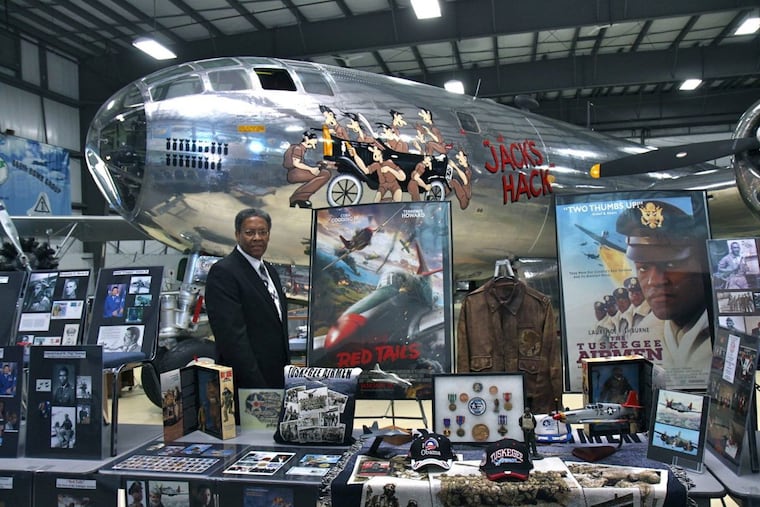Pioneering black hot air balloon pilot returns to Philly
Bill Costen will join fellow hot air balloonists in Philadelphia this week for FAVIA 225, to celebrate the 225th anniversary of the first American hot air balloon flight.

When Bill Costen, the first black commercial hot-air balloon pilot, goes flying, he loves to watch the faces of the people soaring with him. The faces, he explained, react to "everything" the balloon passes over.
A herd of deer running. Sports action in a stadium. A flock of birds, and sometimes even an eagle.
Costen, 70, has been hot-air ballooning for 42 years and has seen a lot up there. He's bringing his stories to Philadelphia this week.
The former professional football player and Connecticut resident will be in town for FAVIA 225, an event commemorating the 225th anniversary of the first hot-air balloon flight in America. French pilot Jean-Pierre Blanchard made it – from Philadelphia – in 1793.
Along with FAVIA, which stands for "First Air Voyage in America," the Balloon Federation of America will also hold its national convention, beginning Thursday. In 2016, Costen won the federation's Ed Yost Master Pilot Award, an honor given to pilots for successfully flying for four decades or more. Costen owns a traveling museum exhibit, which he will have at the conference to present about the history of ballooning.
In Blanchard's day, hot-air ballooning fascinated the Founding Fathers. Tom Crouch, a curator in the National Air and Space Museum's aeronautics department, explained that it held a certain symbolism in early America: By releasing the "chains of tyranny," the "chains of gravity" could be untethered as well, he said. Philadelphia, then the nation's capital, was an important stage.
In a modern context, though, ballooning is a niche sport. A balloonist needs not only piloting skills, but a crew to follow a wind-guided path. Ideally, ballooning sites are in wide-open spaces, away from the power lines and tall buildings of a cityscape. Scheduling is weather-dependent, and weather isn't always hospitable in Connecticut, where Costen fell in love with ballooning.
As a defensive tackle for the Buffalo Bills, he knew O.J. Simpson. Al Cowlings, the former Bills linebacker who drove the Bronco in Simpson's televised police chase, was Costen's roommate. That hot-air ballooning became his trade after football was a "pure accident," said Costen. A cousin asked him in 1975 if he wanted to start a balloon club, and Costen surprised him by saying yes.
"At that time, there were very few balloon pilots in the country," said Costen. "So it was a challenge getting my licenses and everything, and starting out in ballooning."
He couldn't find an instructor who could see him through all of the training needed for a license. So, Costen spent months collecting hours with various instructors he met at conferences.
In 1978, 185 years after Blanchard's flight, Costen lifted off from the Philadelphia Museum of Art, taking part in a balloon race. Heading east, his balloon wafted across the Ben Franklin Bridge, as Costen nervously looked for an ideal landing spot. He remembers touching down in a cornfield in Cherry Hill. Through the high stalks, he noticed a group of kids running over in excitement. The owner of the field, he said, wasn't too happy, though. Costen recalls hearing him make a racial remark: "It's bad enough I see them walking down the street, now they're dropping out of the sky."
Costen, Crouch, and Glen Moyer, the editor of Balloon Federation of America's Ballooning Journal, are all unsure why there have been so few black hot-air balloon pilots. In 1977, an Ebony magazine feature on hot-air ballooning counted Costen as one of two black pilots in the country. "As more blacks are exposed to the sport, I know that they'll get hooked," Costen told the magazine back then. "That's a fact!"
Yet still, the ballooning world lacks diversity. "If I've taken 15,000 people, only about 40 have been black," Costen said Saturday.
Ballooning Journal hasn't tracked racial demographics among pilots, but Moyer said that black participation remains remarkably low. He theorized that balloonists often are brought into the sport by those close to them.
"The sport exploded in the late '70s and the early '80s, but there traditionally hasn't been much participation," said Moyer. African Americans entering "the sport through friends and familiarity just has never been there."
While Costen has heard bigoted comments throughout the years, he thinks that his status as a former NFL player allowed him to avoid some of the harshest forms of discrimination. "Racist people, they love sports," he said.
Costen's daughter is currently working on a documentary on his life. Aside from ballooning and football, Costen, who grew up in Omaha, Neb., also works as a photojournalist and is a passionate collector of black memorabilia, which led to his traveling archive, the Costen Cultural Exhibit.
"He's a rare treat as a human being," said Dwight Bachman, a friend. When Costen took him flying, "the only thing you could hear was that hoosh of the helium released up in the air. It was like walking on air."
FAVIA hopes to re-enact Blanchard's flight this week – weather permitting. Costen is looking forward to exhibiting on ballooning, with some black history mixed in, too.
"I don't think there's anything better on Earth, in terms of total fun, total excitement, total bewilderment," said Costen. "Every once in a while, you wish you hadn't gotten up that morning. But most of the time it's wonderful."